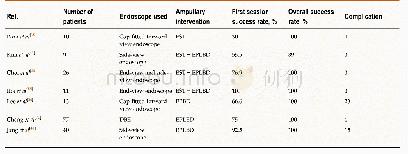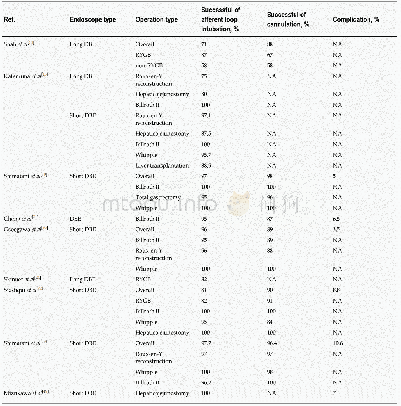《Table 4 Success rates of spiral enteroscope-assisted endoscopic retrograde cholangiopancreatography
 提示:宽带有限、当前游客访问压缩模式
提示:宽带有限、当前游客访问压缩模式
本系列图表出处文件名:随高清版一同展现
《Current status of endoscopic retrograde cholangiopancreatography in patients with surgically altered anatomy》
RYGB:Roux-en-Y gastric bypass.
Improved endoscope insertion is a major factor of the 90%-100%success rate;if insertion to the afferent limb is successful,the cannulation is always successful(Tables1-4).Kato et al[30]reported a similar cannulation success rate of 60%-100%among all reconstruction types which is as same as normal anatomy patients.However,questions remain regarding how the native papilla or biliopancreatoenteric anastomosis can be identified and cannulated.The position of the native papilla in surgically altered anatomy differs greatly from that in the normal anatomy.Cannulation success rates in patients with a native papilla are lower than those in patients with a biliopancreatic anastomosis because of the sphincter muscle.Knowing the position of the working channel in the endoscopic view of each endoscope type is important to rotate the papilla into the proper en face view position;if the papilla cannot be adjusted to the proper view,cannulation may be difficult.Native papilla cannulation in Billroth II reconstruction is much more difficult because the papilla is in the reverse orientation;the forward-view endoscope thus shows a tangential,oblique,and inverted papilla.The use of a catheter oriented straight out from the working channel is better.Ishii et al[31]reported a J-turn technique that advanced the scope into the inferior duodenal angle,moving it to a retroflex position to facilitate cannulation in Roux-en-Y reconstruction with a short distance from the papilla in the tangential direction;however,caution is needed because of the risk of perforation.Okabe et al[32]proposed that a softer single-lumen catheter is suitable for the native papilla,while a stiffer double-/triple-lumen catheter is suitable for anastomosis cannulation because of the larger opening.
| 图表编号 | XD0087245500 严禁用于非法目的 |
|---|---|
| 绘制时间 | 2019.07.14 |
| 作者 | Chonlada Krutsri、Mitsuhiro Kida、Hiroshi Yamauchi、Tomohisa Iwai、Hiroshi Imaizumi、Wasaburo Koizumi |
| 绘制单位 | Department of Surgery, Faculty of Medicine, Ramathibodi Hospital, Mahidol University、Department of Gastroenterology, Graduate School of Medicine, Kitasato University Hospital、Department of Gastroenterology, Graduate School of Medicine, Kitasato University |
| 更多格式 | 高清、无水印(增值服务) |
查看“Table 4 Success rates of spiral enteroscope-assisted endoscopic retrograde cholangiopancreatography in surgically altere”的人还看了
-

- Table 1 Success rates of conventional duodenoscope and forward-view endoscope in Billroth II operation
-

- Table 7 Success rates of stone removal in Billroth II reconstruction in different ampullary interventions
-

- Table 6 Success rates of double balloon enteroscope, single balloon enteroscope, and spiral enteroscope in surgically al
-

- Table 2 Success rate of long and short double-balloon enteroscope-assisted endoscopic retrograde cholangiopancreatograph





